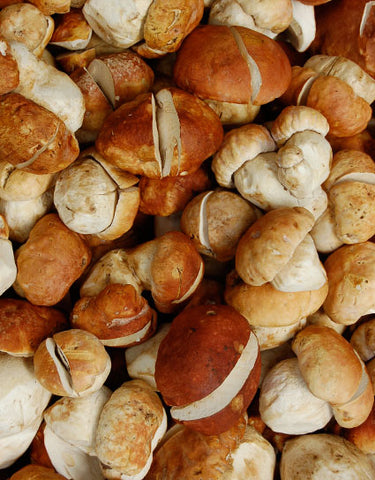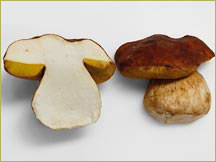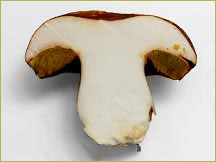Porcini Mushrooms
 (King Bolete, Cépe)
(King Bolete, Cépe)
Boletus edulis, B.aereus, B. appendiculatus and others
This delicious and beloved mushroom is found almost everywhere. It makes its bulbous appearance from Alaska to Uganda and from Siberia to Mexico. If only it could be found all the time. Its three to four week fruiting season is never long enough. This is probably the most popular wild mushroom in the world. Just about the only country that isn’t mad for porcini is China, yet they have plenty growing there which are harvested, dried and happily exported in huge quantities to Italy and other porcini-mad countries.
There are probably a hundred names for this Boletus edulis, depending on where you are. I wish I had fought harder for the American usage of King Bolete , and even Queen Bolete (B. aureus). The common name “porcini” has won the Common-Name Derby in this country.
See The Wild Table pages 181-183, and 331 for recipes and much more about this royalty of the mushroom kingdom.
|
Cleaning After a little knife cut on the bottom to look for any obvious worm holes, the next tool I reach for is a potato peeler. I peel the dirty base off leaving a nice smooth bottom. A strong wipe with a wet wash cloth and the mushroom is ready to cook. If you’re not going to cook them immediately, check the mushrooms for worm holes. Just cut the entire mushroom in half from top to bottom and look inside. If you want to preserve the mushroom shape, drive your knife into the mushroom one third or halfway as if you were doing this same vertical cut, then twist the knife sideways. You’ll be able to peek inside the opened wedge for telltale holes. Seasonality
Cooking These mushrooms’ famously rich flavor comes through, sautéed, grilled, or roasted. You can hardly go wrong cooking them however your heart desires. Preservation Drying porcini is the most common and most useful method of preservation. I believe that it’s worth the extra trouble to clean the mushrooms before slicing and drying. This makes the option of grinding the dried porcini into a grit and dirt free powder later. Porcini powder should be in every kitchen. Once you begin to use it, you’ll never know how you did without it. dried porcini Freezing is a wonderful but lesser known option. Sliced, diced, or halved, CLEAN porcini are easily popped into the freezer. There is a secret technique for cooking with these frozen mushrooms. You must take them out of the freezer and put them in the refrigerator the night before you plan to use them. The mushroom will be in a uniform, semi-frozen state the next day. Put this semi-frozen mushroom directly into a very hot oiled sauté pan or into a pre-heated roasting pan into a hot oven. They are excellent. Your guests are likely to think they were fresh porcini. Find dried porcini in three quantity sizes in our store. You can also find Porcini Powder, Salt and Seasonings as well as Porcini Polenta, Risotto and True Wild Rice Mix. Storage Perhaps Boletes’ only shortcoming is its very short shelf life. Insects love them as much as we do. We however, do not get hatch and grow rapidly and hungrily INSIDE the mushroom as the bugs are able to do. What a nice fantasy though. Perhaps there’s a Willy Wonka mushroom wonderland for fungus-crazed humans like us. If your Boletes are worm-free, they may last 2-4 days in your refrigerator. Quality #1 Grade - These are the young firm button porcini/Kings/Cepes that everyone adores. The “pores” are white to cream in color- this reflects their youth. The olive-brown spores have barely formed, hence the pale pore color. There are no worm holes. This grade is required for shaving raw in salad presentations.
#2 Grade - The mushrooms are gorgeous and have a yellow color to the pores as the spores are maturing. No worm holes.
#3 Grade - The mushrooms are generally larger in size as the mushroom has grown and the spores have matured. The pores are mustard-yellow to brown in color.
|




